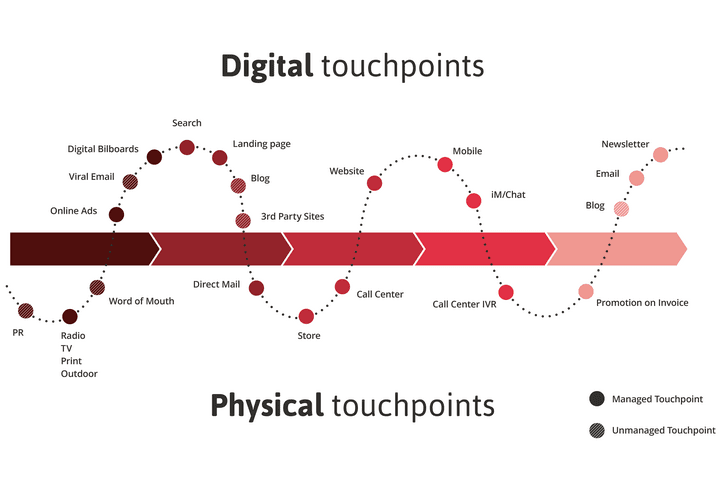
The importance of customer experience and the role of your physical store
Today, creating a good customer experience is more important than ever before. But what do we mean by customer experience, and what does this actually entail for your physical store in practice? In this blog post, you will learn how to get your customer experience on-point in just four simple steps. We will also provide inspiration on how technology can be used to ‘boost’ the customer experience in your physical store.
What is customer experience and why is it so important?
Customer experience (CX) is a very broad concept, encompassing every moment of interaction between your (potential) customer and your brand, both online and offline. It encapsulates your (potential) customer's entire customer journey, from their first impression of your brand from street signs or online advertising, to visits to your physical store or online purchases from your online store.
By identifying every possible moment of interaction - or touchpoint - and putting together one consistent overarching brand story that matches your customer's expectations, you are guaranteed to make an instant impact. Because a good customer experience not only produces enthusiastic and loyal customers. By paying enough attention to the experience, you will be turning your customers into an ambassadors, who in turn will be passionate in sharing their positive experiences with others.

From the image above, it is clear that the physical store is merely one part of the wider Customer Journey. Before delving deeper into the potential of this powerful physical touchpoint, let's take a step back. Ultimately, everything starts with identifying every stage of the Customer Journey. This often proves quite the mental exercise, one that cannot be done overnight. However, by following the steps below, you will be well on your way.
Step-by-step guide for an exceptional customer experience:
Step 1: identify your target audience
Your (potential) customer is central to all this! Therefore, everything starts with thorough research of your target audience. Who are your customers? What are their needs? To answer these questions, we often turn to qualitative research techniques. Engage with your customer, ask the right questions and immerse yourself in their world until you truly understand them.
Step 2: map out every stage of the customer journey
‘Customer journey mapping’ is perhaps the most commonly used technique for identifying the different stages of the customer journey. This involves recording every point of interaction with your brand, which, over time, will make for a clearer picture (see also the image above). Such points of interaction are wide-ranging, from conversations with staff to browsing the store window, seeing online ads or receiving promotional emails. By mapping out all your different touchpoints, you will be able to immediately uncover any points of interaction where you may be underperforming in terms of customer experience and brand story consistency.
Step 3: decide what type of brand identity you wish to project
Once you have mapped out all your touchpoints, it is time to define your brand identity. As a brand, what is it you stand for? What image do you want to project? While this is not rocket science, by consciously jotting this down, it becomes much easier to subsequently translate your brand identity into one consistent brand story across all touchpoints.
Stap 4: time for action!
Time to put theory into practice. Make sure your brand identity permeates throughout all touchpoints that make up your Customer Journey. Convey one consistent brand story across all channels, and involve your employees in this too, so that everyone within your organisation is up to speed and on board with this story from the off.
The role of physical stores within the Customer Journey
As already mentioned, the physical store is just one part of the wider Customer Journey. However, don't underestimate the power of your physical store as a touchpoint along the way. While nowadays everything online is booming, the physical store remains a particularly crucial point of customer interaction, one where you can reinforce your overall brand experience. Your store is a place where you can fully immerse your customers in your brand culture, as there you are in a position to truly stimulate all their senses ;-).
Let us finish, then, with some inspiring examples of where technology has been used within physical stores to enhance the wider Customer Journey.
Example 1: JBC conveys story of sustainability with new concept store

At JBC, they are currently embarking on a (r)evolution in sustainability throughout the chain. And this is something that’s been given prominence within their physical store. Not only was part of the store constructed using recycled materials, there are also several interactive digital gadgets that promote their sustainable credentials. From a DIY recycling machine to an interactive magic mirror, JBC is making the concept of sustainability accessible to the whole family, while at the same time delivering an experience that is sure to stay with them.
Example 2: Xandres commits to exceptional in-store customer servic

Xandres are also managing to make a difference with their physical store, delivering outstanding customer service with the support of digital technology. In doing so, Xandres are bringing their online story into the physical store itself by installing several interactive kiosks. Should their size or colour not be available in-store, customers can now place orders on-the-spot, with the option of home or in-store delivery. What’s more, the Xandres app also provides a noteworthy boost to their overall level of customer service. In the app, customers are able to compile a list of clothes they wish to try on, which are then brought to the fitting rooms by a dedicated member of staff. This gives the shop assistant more time with the customer, while the customer is no longer resigned to walking across the shop floor carrying four items under their arm.
Example 3: Coco & Sebas provide a delicious experience through their brand store

For Coco & Sebas, it is clear that the physical store remains perhaps their most important point of customer interaction. With a tagline like ‘sparkle up your day’, it is evident that seeing, smelling and tasting the product is key. With every visit to the brand store, Coco & Sebas aim to deliver a sense of ‘sparkle’ for their customers, who are ultimately treated as guests. They are provided with samples, product advice and, should there be a wait, a nice cup of coffee. Every detail has been well thought-out, with digital screens serving to further immerse the customers in the overall brand experience.
Wondering how technology can also contribute to an improved customer experience in your store? We would be delighted to help you in effortlessly translating your brand identity into a unique store concept.
For more information, contact us at info@dobit.com.
Get in touch!
Feel free to contact us
More inspiration or information?
Contact us or drop by. We are happy to help you!



